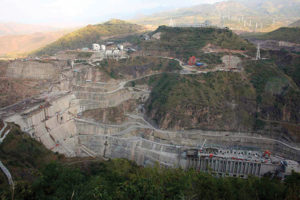- Stay Connected
Completion of Gibe III has been a significant achievement for Ethiopia. Gibe III stands as a showcase of how large, multi-party projects can be managed and taken from inception to operation within nine years, despite financial, geological, and technical hurdles

by Sonal Patel
Building the 1,870-MW Gibe III hydroelectric project required unprecedented solutions that took into account the remoteness of the site, the narrow gorge where the dam is located, the height of the dam, and challenges in sourcing reliable materials.
Split almost diagonally by the East African Rift System, Ethiopia is a rugged geological wonderland of mountain ranges and basins. Etched with large river gorges, and with a rainy season that lasts three to four months, the country has an overall hydroelectric potential estimated at around 160 TWh/year.
Although the landlocked country only has about 2.3 GW of installed capacity (86% of which is hydropower) to serve its population of more than 95 million, the government of Ethiopia is on a drive to exploit this massive potential. Under its latest Growth and Transformation plan, the country wants to increase capacity to 10 GW by 2018, to 17 GW by 2020, and to 35 GW by 2037 to sustain soaring economic growth and make Ethiopia a renewable power hub in East Africa.
Among key projects is the 1.8-GW Gibe III (also known as Gilgel Gibe III) in Ethiopia’s southwestern Southern Nations Nationalities and Peoples’ Region. The project is located on the Omo River, a 760-kilometer (km)-long perennial body of water that rises in the Shewan highlands and snakes southward until finally emptying into Lake Turkana on the border with Kenya. Long considered a hydro powerhouse, Ethiopia started construction on the first dam on the Omo River—Gilgel Gibe I—in 1986. The 184-MW rock-filled embankment dam wasn’t completed until 2004, but it spurred the start of construction for the 420-MW Gibe II in 2005. That project, which has a 50-meter (m)-high gravity dam and Pelton turbines, was completed in 2010 with the technical backing of Italian construction and civil engineering firm Salini Impregilo.
Kicking off the Third Phase
In 2006, while construction for Gibe II was ongoing, Ethiopian Electric Power (EEP), a government-owned enterprise that is the sole provider of most of Ethiopia’s bulk power, awarded Salini Impregilo an engineering, construction, and procurement contract for the third project on the Gibe-Omo hydroelectric cascade, Gibe III. Studio Pietrangeli, another Italian firm that provides specialized consulting engineering services for hydropower, designed the innovative project that would become the biggest engineering structure in the history of Ethiopia and provided a feasibility study and technical supervision during construction. French company Tractebel Engineering provided project management services, including review of the feasibility study and basic design, supervision of design and construction, and development and implementation of the environmental management plan.
The companies eventually selected a dam type based on the site’s unique conditions. The project is sited 150 km downstream from Gibe II in an area where the Omo River flows through narrow valleys and deep canyons (Figure 1). This was favorable to construction of a reservoir with a capacity of 14 cubic km (designed to enable flood regulation), but it presented “extremely challenging logistical conditions for dam construction,” said Salini Impregilo. While concrete arch and concrete-faced rockfill were considered, the final design called for a 240-m-high roller compacted concrete (RCC) gravity dam—one of the tallest in the world—and a open-air powerhouse located on the left bank of the river, about 500 m downstream of the dam axis, housing 10 Francis turbine units with a total installed capacity of 1,870 MW. Other key characteristics of the project included.

